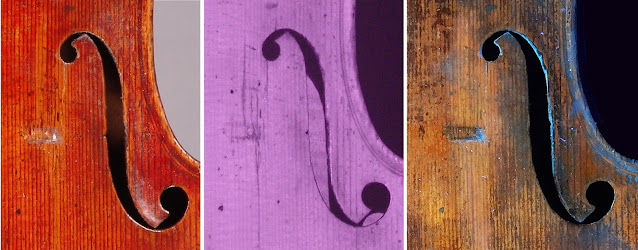ECR Casebook: Detecting half-tone lithography on an obscured label.
German violin | Benjamin Hebbert
Recently a colleague brought to us a German nineteenth century violin with a manuscript label written in kurrentschrift (not sutterlein, as we reported originally) which is typically difficult to read, and obscured by dirt and chemical damage. As is normal in a case like this, the instrument was closed and the only way to examine it was through the soundholes. We believed that we could read "Georg" at the beginning and a date of 1820. From the initial photographs sent to us there was no reason to believe that the label wasn't handwritten, and no particular reason to dispute its belonging to the instrument.
 |
| Our own photograph of the label with a strong interior light. |
In the process of trying to create a clearer image of the label for the purposes of transcribing it, we observed under blue light (Lumatec M05 using a 445nm light source) a clear indication of a lithographic halftone screen over the white parts of the label. In order to demonstrate this, we photographed a sample of the label under a macro lens under the same light conditions, as it was impractical to try to record the whole label on an SLR camera. However our sample (the edge around the 1820 date) was sufficient to demonstrate the overall use of this printing technique.
 |
| Close-up of the same area. where the dots of the half-tone are visible as a screen across the label's surface. |
It is sometimes possible to view the lithographic halftone screen with the naked eye with minimal magnification. Subsequent photographs taken under normal light conditions show areas of halftone that has not been obscured by contaminants. On this example, however, seeing these characteristics with the naked eye and without prior analysis to guide us to the relevant features proved unusually difficult.
 |
| Detail of the label taken with an iPhone camera with strong internal light. |
At a higher level of magnification we can see how the dots merge into the lettering.
Around 1900 there were many books produced with collections of labels intended to assist experts in attribution, but ultimately having the reverse effect of providing sources for fake labels. We have several of these books in our reference collection although our collection is not comprehensive, and were able to find a corresponding image in Practical History of the Violin published by H. Bauer's Music Co, New York, 1911 and printed on a glossy paper, different from the label in the violin. Here the images are reproduced in collotype, and close inspection of the original page shows, as is typical of re-photographed media of the time, there are efforts to retouch the manuscript in order to give it greater definition. Presently our library is not extensive enough to determine the original source for this label in lithograph form.
The process of reproducing these lithographed images as a collotype involved photographing the pages of the original printed (lithograph) book, and then retouching the photographic plates in order to rephotograph the final image. Here we see that the printer's technician was insensitive to the kurrentschrift and has inked over it in a manner that is less legible than the original, and in which he has changed the shapes of some of the letters - the last letter of Georg, for example now resembles a "y". However, there is enough legibility in this to identify "Frankfurt" as the word on the second line of the label. The technician has also provided a textured background for the label that is cleaner than the original in order to aid in legibility. Parallel diagonal lines can be seen across the image when magnified. One purpose of this is to mask the screen of dots from the original lithograph. Images in successive magnifications show the overpainted retouching and masking.
When we find the original source we will write a postscript to the postscript.









Comments
Post a Comment